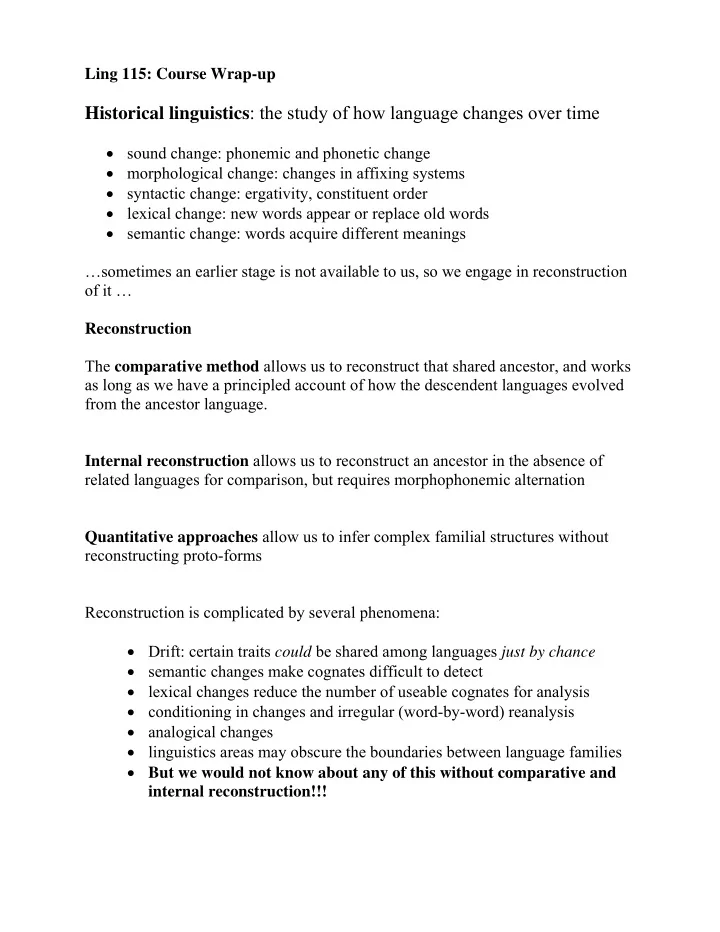

Ling 115: Course Wrap-up Historical linguistics : the study of how language changes over time • sound change: phonemic and phonetic change • morphological change: changes in affixing systems • syntactic change: ergativity, constituent order • lexical change: new words appear or replace old words • semantic change: words acquire different meanings …sometimes an earlier stage is not available to us, so we engage in reconstruction of it … Reconstruction The comparative method allows us to reconstruct that shared ancestor, and works as long as we have a principled account of how the descendent languages evolved from the ancestor language. Internal reconstruction allows us to reconstruct an ancestor in the absence of related languages for comparison, but requires morphophonemic alternation Quantitative approaches allow us to infer complex familial structures without reconstructing proto-forms Reconstruction is complicated by several phenomena: • Drift: certain traits could be shared among languages just by chance • semantic changes make cognates difficult to detect • lexical changes reduce the number of useable cognates for analysis • conditioning in changes and irregular (word-by-word) reanalysis • analogical changes • linguistics areas may obscure the boundaries between language families • But we would not know about any of this without comparative and internal reconstruction!!!
Subgrouping Enough careful comparative analysis allows us to establish more complex relationships among 3 or more related languages. Lexical changes can actually be used to the same end. Observing language change variation: multiple forms for same concept lexical diffusion: progression of innovation differs across words of a language. same applies to variation. Why do languages change? Arbitrariness, variation, polysemy, simplification, and structural pressure
Causes and character of change Arbitrariness : sound (form) and meaning (function) are arbitrarily linked Variation : change requires variability in sound or meaning • phonetic or phonemic change: o at some point, the old and new variants are both available: o same function, different form • morpho-syntactic change: o at some point, the old and new structures are both available: o same function, different form • reanalysis: o same function and form, but different abstract structure • semantic change: o at some point, the old and new meanings are both available: o same form, different function variability (and change) diffuses through a population and through the lexicon Simplification • Lenition, assimilation, fusion, deletion etc.; analogy • but : no single ‘simplicity’ metric • simplification along one dimension usually precipitates complexity somewhere else o chain shifts: first step may be ease-driven, but consequent steps are not o syncopation: deletion, but clusters result o some ‘lenited’ sounds can still be phonetically challenging • agglutination → inflection: o fewer morphemes per word, but individual morphemes carry more functions • inflection → isolation: o words are even shorter, but syntax becomes more complex • isolation → agglutination: o phonological reduction, but morphology becomes complex
Structural pressure Balancing phonemic inventories But, gaps still exist even so - some such “gaps” are principled ŋ , p/g: languages with voicing contrasts Language genesis and convergence Languages in contact may precipitate new languages pidgins and creoles: borrowed lexical items, but new phonology and morpho- syntax.
Languages of Mediterranean Europe, pre-Roman expansion (Don Ringe) 1. Indo-European (IE) languages: o Greek , splintered into about two dozen (known) dialects, in Greece, the Aegean islands, and areas further east (the Asia Minor seaboard, Pamphylia, Cyprus); clearly one language, very different from all others; o Messapic , in southeastern Italy, largely uninterpretable but with proper names exhibiting IE nominal morphology; o Venetic , in the lowlands of northeastern Italy; o Italic: � Latino-Faliscan, including � Latin , originally confined to Latium, and � Faliscan , spoken at Falerii on the upper Tiber (surrounded by Etruscan territory); � Sabellian, including � South Picene , east of the Appennines, and � a dialect continuum from Oscan in the south through the hill dialects east of Rome to Umbrian , as well as � a poorly attested dialect spoken in Campania before the Samnite invasion which might or might not have been part of the same dialect continuum; � Sicel , poorly attested from Sicily o the Celtic subfamily, represented by � Hispano-Celtic in northeastern Spain; � Cisalpine Celtic around the lakes of northern Italy, and � Trans-alpine Celtic in what is now France 2. “ Minoan ”: the language of the Linear A script, uninterpretable but clearly neither IE nor Semitic 3. “ Eteocretan ”: The language of some uninterpretable inscriptions in the Greek alphabet from eastern Crete 4. Elymian , known from some coins and tombs in Sicily 5. Tyrrhenian languages (Rix 1998): o Etruscan o Lemnian , Lemnos, north-eastern Aegean o possibly Raetic , northeastern Italy 6. A language inscribed on stone slabs in Novilara (east of San Marino) 7. Iberian , attested in inscriptions throughout southern and eastern Spain 8. Tartessian , known from 78 stelae of unknown function found in southwestern Iberia 9. The ancestor of Basque
Recommend
More recommend